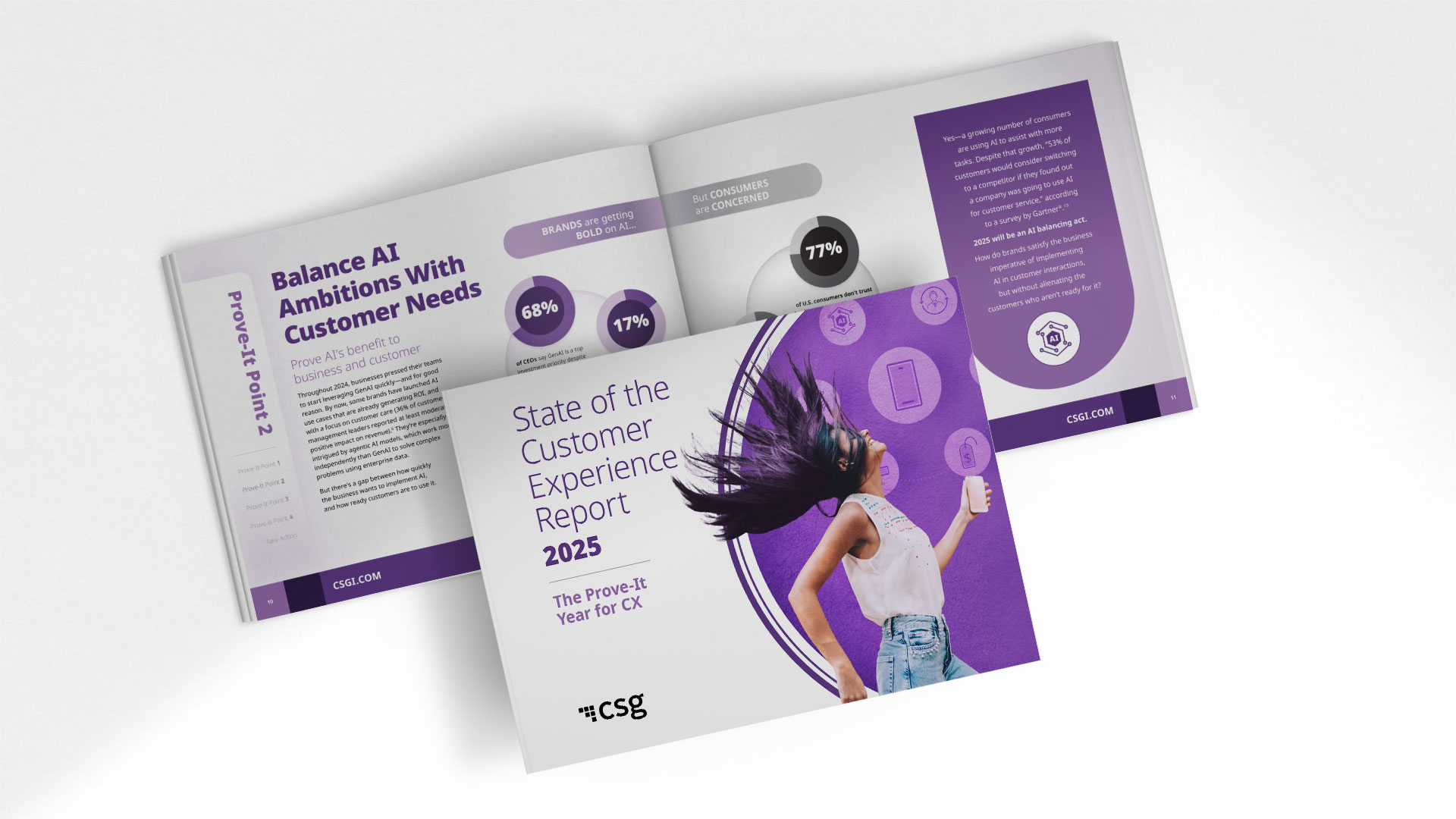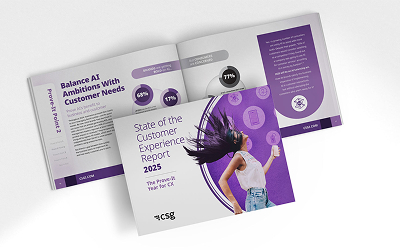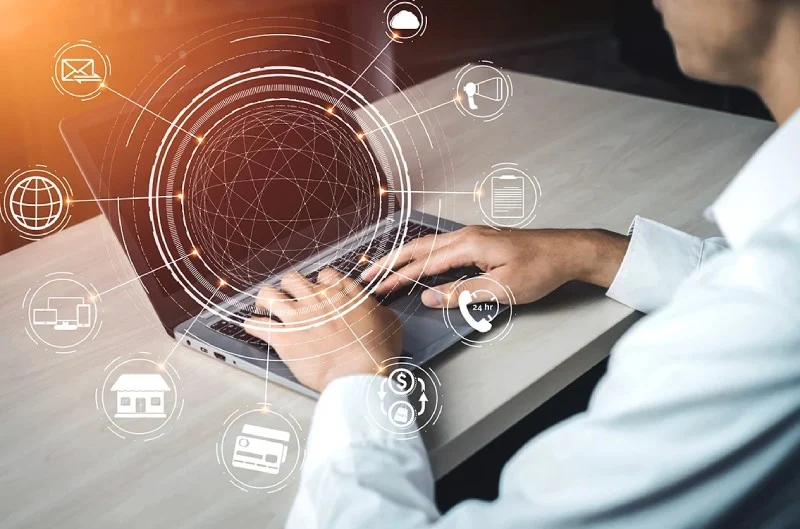Getting the customer experience (CX) correct, or wrong, has a significant impact on your bottom line. “Customer-obsessed” organizations, according to Forrester, report 41% faster revenue growth and 51% better customer retention than other organizations. A recent survey found that 88% of consumers report having stopped doing business with a company due to poor customer service.
What is CX, exactly? Ask 10 marketing, customer experience, customer support or sales directors, and you’ll get 10 different answers. But they’ll agree CX is a big deal. Improving CX is a top priority for many businesses’ boards and leaders, who are investing considerable money and resources to “delight” customers.
According to a commissioned global study of 484 CX leaders conducted by Forrester Consulting on behalf of CSG, 58% are currently spending more than $2.5 million on CX initiatives and strategies. Similarly, investing in new products and services to streamline CX is a high or critical priority for 64% of respondents.
Focusing on improving CX can help your organization build loyalty, increase retention and transform customers into brand advocates. CX improvements will boost revenue and support other critical business goals. Read on to better understand CX to help you pinpoint where today’s customer experience is broken and how to go about fixing it.
What Is Customer Experience Strategy?
Although there is no universal definition of CX, customer experience is widely known as the customer’s perceptions of a company based on interactions with employees across various channels, systems or products. Gartner defines customer experience as “the customer’s perceptions and related feelings caused by the one-off and cumulative effect of interactions with a supplier’s employees, systems, channels or products.”
The customer experience strategy refers to your company’s plan to keep these interactions personalized, consistent and positive. The effects of these interactions are often one-off and cumulative, like in the definition above, and understanding that is key to understanding the five components of CX.
What Are the 5 Key Customer Experience Components?
To improve CX and measure how technology solutions impact it, you must start by:
-
- Understanding the five customer experience components
-
- Aligning your organization with these five components
-
- Enabling a technology-driven research and design team to analyze and understand customer behavior
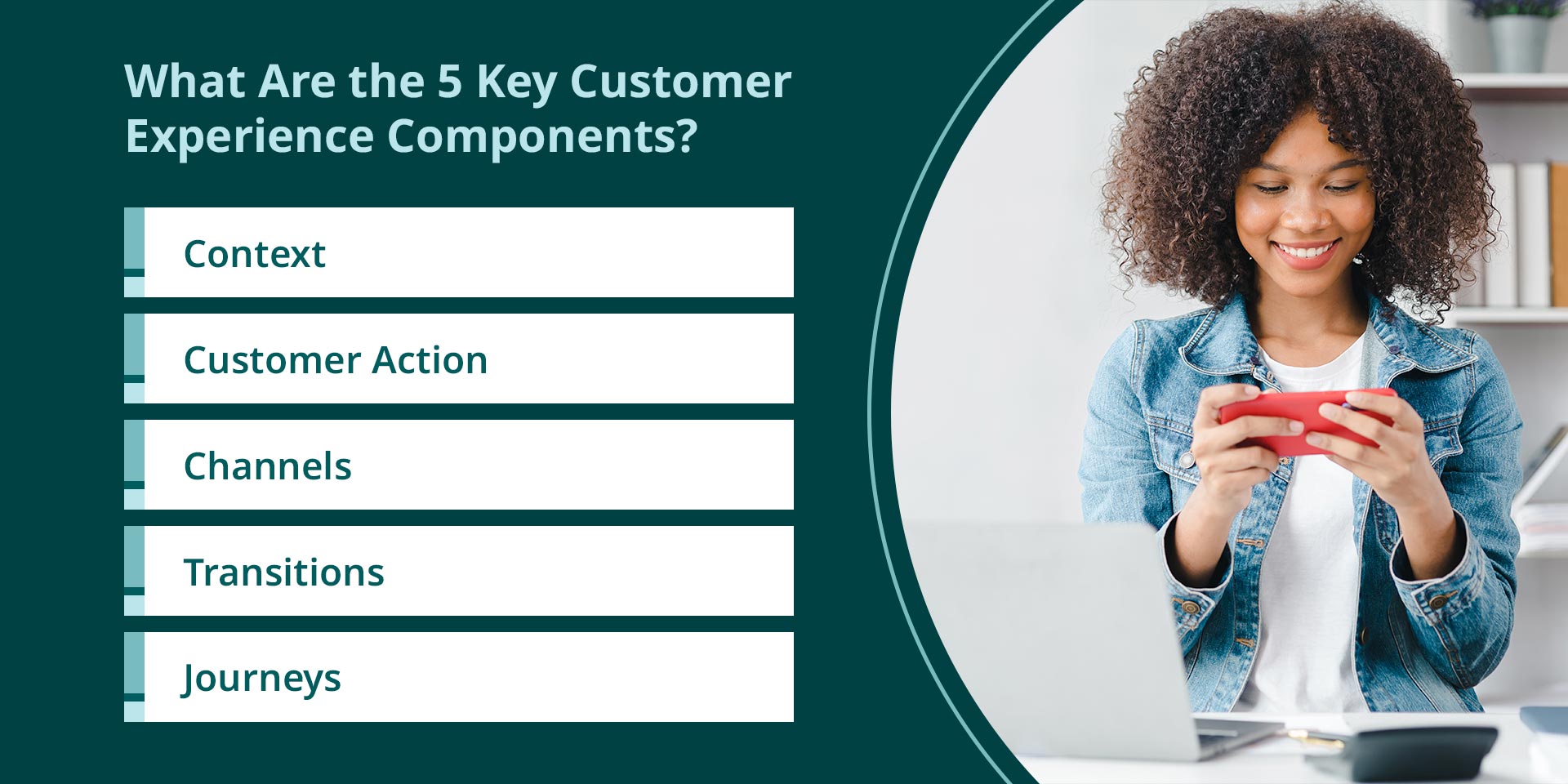
1. Context
Context includes the customer’s location, physical environment and mental and emotional state when interacting with a product or service. Think about a customer on vacation when suddenly their credit card is declined. A financial services company should account for the timeliness of the fraud notification delivery so as not to let financial anxieties burden a customer on their time off.
2. Customer Action
This refers to the actions customers take to interact with a service, product or system and achieve their desired outcomes—also known as Jobs to Be Done. For instance, a patient will need to log into their MyChart app to view medical test results. Thus, a healthcare organization must account for this patient’s action when designing an experience around test result delivery.
3. Channels
Channels are the core part of the experience where customers interact with delivered products or services. Communication channels could be:
-
- Websites
-
- Apps
-
- Delivery and logistics partners
-
- Contact centers
-
- Physical locations
-
- Kiosks
-
- Text messages
To improve CX, consider what the customer sees, hears and feels while interacting with your brand. If the automated hold messages are lengthy and keep pushing customers to online channels, despite the fact that they tried the online channels before calling and failed, it doesn’t make for a good channel experience.
4. Transitions
This refers to how customers move back and forth between actions. It could include:
-
- Waiting for products or services to arrive
-
- Waiting for complaints to be resolved
-
- Traveling to (and parking at) offices or retail stores
-
- Finding the contact center number
-
- Being routed between channels
For example, if a replacement router doesn’t arrive promptly from the internet provider, the customer wonders if it was delivered to the wrong address.
They might frantically switch back and forth between confirmation emails on their phones and FAQs online. Mastering this multichannel experience is necessary to deliver easy, consistent experiences across channels.
5. Journeys
Journeys refer to sequences of actions or steps, through different channels, connected with transitions to enable customers to achieve a certain outcome. Understanding and deliberately designing a proactive and personalized journey is as important as designing in-channel interactions, especially in logistical areas where waiting is a core part of the experience.
For instance, a retail organization needs to account for every touchpoint, from a customer placing the order to driving to the store to physically picking up the goods.
A great customer journey or experience is defined by these three characteristics:
- Clarifying what happens next and what is expected from the customer
- Nudging and guiding the customer through the next best action or experience
- Helping the customer navigate channels in the most effective, proactive and personalized manner
Why CX Is Frequently Misunderstood
The Cambridge Dictionary defines “experience” as “the way that something happens and how it makes you feel.” When starting with a vague, hazy description, it’s no wonder brands struggle to deliver the experiences customers expect.
How do you measure feelings? And how do you provide different experiences to satisfy each customer’s expectations, at scale? Business leaders excel at tracking and interpreting cold, hard facts and figures—like the number of sales or length of customer service calls—not the complexity of customer interactions.
Customer experience is often used interchangeably with “customer journey,” “user experience” and Net Promoter Score (NPS). While these concepts are all related to customer experience, they are not the same.
Start by Understanding ‘the What’ Using Advanced Analytics Across the Five Components
To design and deliver personalized and proactive experiences, your organization must develop a clear and quantitative understanding of “what” its current experience is across the five components. You must use a tightly harmonized suite of omnichannel communications and journey discovery analytics to understand how customers engage today—through which channels and contexts—to proceed through journeys and achieve their desired outcomes.
Uncover ‘the Why’ Behind Your Customers’ Actions
With a clear and real-time view of the current experience elements, user research and design capability will take quantitative information to the next level. This capability applies qualitative research techniques such as interviews, focus groups, fly-on-the-wall observation or service safaris to dig deeper behind the numbers and understand the root cause behind customer behavior and triggers.
Only by combining the quantitative and qualitative parts of the puzzle—the what and the why—will your organization be able to find the real problems it needs to solve to deliver effortless experiences.
You can collaborate across your organization to define, design, test and deploy innovative solutions to real problems, and not just the symptoms.
Tips for Enhancing the Customer Experience
If you’re aiming for improved customer satisfaction and increased customer lifetime value, it’s important to focus on the experiences you create with each interaction. Here are our top tips for improving your customer experience strategy.
1. Understand Your Customers’ Needs
Unhappy customers are often unheard or misunderstood customers. Improving your customers’ experience starts with understanding what consumers need and want—not what you think they need and want. Speak with your consumers directly and frequently at all stages of the customer journey through various touchpoints in your organization. Go beyond customer service team insights and drill deep into where friction points exist throughout the consumer lifecycle.
Action Plan
Explore what your consumers want, need and prefer. To do that, you can:
-
- Conduct customer surveys
-
- Analyze feedback to better understand what consumers are experiencing
-
- Identify what customers find frustrating, including what makes them disengage and drop off
-
- Analyze what consumers appreciate so you can replicate positive efforts
-
- Review customer support interactions, such as chat support, email correspondence and contact center transcripts
-
- Discover what customers expect from your organization
2. Leverage Customer Journey Mapping
To act on what your customers need and want, you must stop considering use cases in a vacuum. A proactive way to improve customer experience is through journey mapping.
Customer journey mapping evaluates consumer experiences from the customers’ perspective and considers pain points in their interactions with your organization. Once you understand where your customers are encountering frustrations along the journey, you can act to smooth their pathway to journey completion.
By addressing pain points while also replicating positive interactions, you improve overall CX and deliver better outcomes for your organization. A customer journey map helps you identify and manage the process, providing exceptional end-to-end service.
Action Plan
Mapping can be as simple as collaborating with members of your organization who understand various touchpoints and journeys.
3. Use Customer Journey Orchestration
The next step in improving CX is customer journey orchestration, which connects the gaps between your teams and your systems. To properly manage the customer journey process, you’ll use specialized orchestration software.
Journey orchestration software integrates separate consumer interactions across various touchpoints and creates a series of compelling interactions. These synergized interactions build customer loyalty and enhance engagement.
Without orchestration tools, your company’s communications with consumers are siloed—as a customer engages with your sales, marketing or service departments, each interaction is segmented. By facilitating communication between departments, you make these connections between interactions. This keeps customer journeys from feeling separated and inconsistent, improving CX. Customer journey orchestration enhances interactions by delivering:
-
- Personalized communications based on behavior across channels
-
- Seamless customer service
-
- Cross-channel lead prioritization
-
- The right message at the right time for each customer
Action Plan
Invest in an innovative platform with customer journey orchestration capabilities. You can transform interactions across the entire customer lifecycle, connecting touchpoints and delivering a standard-setting customer experience.
4. Use Journey Analytics Data
Your organization can also leverage journey analytics to improve CX. Journey analytics help you track and measure how consumers interact with your organization across channels and processes. Understanding channels and the ways customers engage with your brand is vital to improving CX.
When you understand your customers’ needs, interests and behaviors at each touchpoint, you can better engage them and deliver more personalized experiences. Journey analytics integrates customer intent with data from various channels, including website, email and contact center analytics. You can use journey analytics to customize content and personalize website interactions.
Conventional analytics focus on the channel’s key performance indicators (KPIs), like time spent browsing your site, clickthrough rate and time to serve. Although valuable, these analytics don’t uncover individual CX pain points.
Journey analytics provides you with:
-
- Insights into customer expectations, needs and wants
-
- An understanding of what efforts are boosting or hindering your revenue
-
- Action items to improve your customer experience and journey
Action Plan
To improve CX, you need continual tracking and monitoring. When your company invests in innovative customer journey analytics software, it gathers the insights it needs to drive conversions, build customer loyalty, boost revenue and reduce costs to serve.
5. Leverage Personalization Strategies
Personalization is another way to improve customer experience. Recent research reveals that 81% of consumers prefer companies that offer personalized experiences, while 70% of consumers feel that speaking with an employee who knows their history is important.
Personalization engages your customers and establishes consumer loyalty and satisfaction. When you customize content and track individual interactions, customers will feel you value their needs and preferences. This builds confidence in and loyalty to your brand, boosting engagement and leading to a positive ROI.
6. Use AI and Tech to Personalize Experiences
Making the most of personalization requires you to leverage all you know about your customers to streamline their journey. Enhancing and tailoring individual journeys strengthens the bond between your organization and its customers.
Instead of sending generic promotions and information to all customers, you can personalize content according to geographic location, browsing history and expressed preferences. Thanks to innovative tech like AI and machine learning, you can customize your offerings. That includes the ability to use natural language processing software to understand what customers are asking in free-form messages and leverage chatbots to ensure your customers have support 24/7.
The latest digital tech is ever-evolving, expanding the level of personalization available in your communications, services and support. Today, AI is a scalable way to engage and reach individuals personally.
Action Plan
To streamline the customer journey and maximize personalization, you can:
-
- Leverage data to customize survey questions
-
- Decide on essential personalization criteria, like location, demographics or purchase history
-
- Use geographic location tech to tailor offerings according to region
-
- Customize deals based on past purchases and behavior
-
- Follow up on survey responses personally to encourage future participation and show you’re invested in each customer
-
- Enable your website with dynamic displays based on user preferences
-
- Collect feedback from customers about personalization efforts and optimize your interactions
7. Enable a Smooth Omnichannel Experience
Your organization has more than one device or channel to focus on. You must shift to an omnichannel mindset to remain competitive and deliver first-rate customer experiences. Delivering omnichannel experiences includes ensuring your online platforms cater to mobile devices, not just desktops. Designs and displays should be responsive and user-friendly to enhance CX.
Beyond your platforms, your organization should establish a connected customer experience online and offline. The customer journey should be seamless, whether your consumers connect with you in person or engage with you via your website, social media or app.
Consumers may connect with your brand on multiple platforms and expect your business to keep track. Suppose a customer connects with you via chat, then switches channels and calls you. They won’t want to repeat the entire conversation.
Omnichannel capabilities provide more consistency for consumers. With so many consumers expecting consistent experiences across channels, your organization should prioritize developing an omnichannel strategy for CX.
Action Plan
Partner with a future-focused organization that will help you deliver a truly omnichannel customer experience.
8. Focus on Employee Training and Engagement
Your employees play a critical role in keeping your consumers engaged and happy. Your customer-facing teams are the brand ambassadors of your organization. Empowering them to deliver customer-centric service takes investment. Conduct regular training programs to help all employees understand your products and services. Training should include:
-
- Product training: Intensive product training will help your employees deliver information and insights to customers with ease. When your employees are confident in their product knowledge, they’ll handle customer interactions effectively. This will speed up response times and allow them to offer frictionless service to customers.
-
- Soft skills training: Soft skills training will help employees learn to engage with customers with more energy, patience and professionalism, leading to enhanced interaction and greater satisfaction.
The happier and more empowered your employees are, the better equipped and inspired they will be to deliver excellent customer experiences.
Action Plan
Establish a customer-centric and employee-centric culture in your organization to boost your profits and employee morale. Get help developing a customer engagement strategy to maximize your results and support your employees.
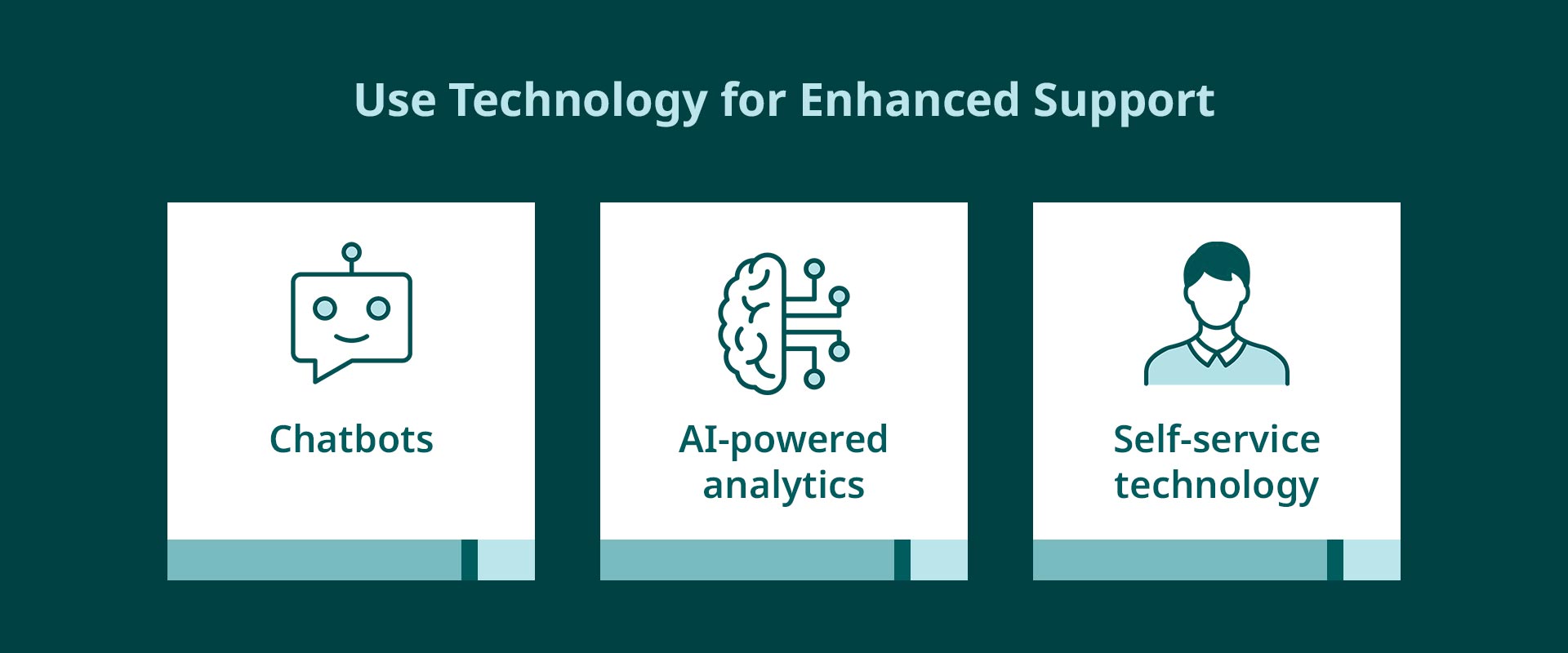
9. Use Technology for Enhanced Support
AI and innovative tech can help you provide superior customer service and experiences. Some of the technologies you can leverage to enhance customer support include:
-
- Chatbots: Chatbot technology speeds up time to serve and provides instant responses to customer inquiries, potentially saving your organization significant customer support costs. Bots answer queries in real time and alleviate pressure from your call centers. The speed of service delivery and 24/7 availability contribute to excellent CX.
-
- AI-powered analytics: Your organization can leverage AI-powered analytics to monitor your most important metrics in real time. Connect and capture data from various points in your company and view key insights on one dashboard. Use these insights to deliver personalized and enhanced service.
-
- Self-service technology: Over 70% of customers want the ability to solve issues independently. Self-service options offer them a great customer experience and free up company support staff to handle queries that will benefit from human intervention. Intuitive self-service platforms will build your organization’s reputation by giving consumers quick and frictionless ways to engage with you.
Action Plan
You can invest in conversational AI technology to reduce your support costs and deliver exceptional CX. Conversational AI understands speech, context and intent, helping consumers get accurate assistance quickly.
10. Monitor and Measure Your Customer Satisfaction
The final step in improving your customer experience is monitoring and measuring customer satisfaction. Your organization can accomplish this by:
-
- Identifying KPIs to measure customer interactions and satisfaction
-
- Regularly monitoring and analyzing customer satisfaction metrics
-
- Reviewing and optimizing strategies based on customer feedback
Action Plan
Leverage customer journey management tracking and monitoring technology to understand why customers buy or drop off across journeys. Use these valuable insights to bolster loyalty and boost sales.
Case Study: A Story of Success
A global retail brand dealing with consumer packaged goods (CPG) wanted to build stronger customer relationships and become its customers’ go-to advisor. One of the retailer’s goals was to expand its relationship with consumers from months to years. Here’s how the retailer created a dynamic online consumer journey:
- The challenge: The brand needed a consumer engagement hub that automatically identified and engaged with each visitor and then guided them to the next stage of the journey. The retailer found that its content wasn’t engaging individuals. Beyond that, the brand website was not tracking where drop-offs were happening, what pages users were visiting and what consumers were doing on the site.
- The need: The retailer needed to understand who was on its website. The brand also wanted its site to show relevant content tailored to each consumer’s unique journey.
- The solution: The brand leveraged CSG Xponent to enhance customer experience. The cloud-based Xponent platform collected vital data the retailer could use to personalize interactions and identify returning consumers. Xponent also used gamification and rewards programs to deliver a dynamic customer journey.
- The results: The project took less than two months from design to implementation, and consumers who visited the retailer’s site began receiving individualized engagement. The Xponent platform also collected real-time data to tailor experiences further. The results? Personalized journeys that last from one day to three years. Plus, the site received more than 30,000 additional visitors in the first eight weeks.
How Can CSG Help Improve Your CX?
Xponent helps create industry-leading customer experiences across channels, leveraging your customers’ data to make it happen. It’s one platform that does it all.
We offer various ways to improve customer experience:
-
- Journey mapping: Our award-winning mapping software helps you understand experiences from a consumer perspective. It identifies pain points you can address to provide high levels of customer satisfaction.
-
- Journey orchestration: CSG’s orchestration tools help you execute journeys by connecting databases and customer-facing systems, delivering seamless and tailored experiences across multiple channels.
-
- Journey analytics: Xponent helps you track and gauge how consumers interact with your organization across multiple platforms. The analytics feature lets you view critical metrics holistically to get big-picture insights about the customer journey and any friction points along the way.
Developing your customer journeys is simple and quick with CSG.
Contact Us Today to Optimize Your CX Strategy
CSG is an award-winning, purpose-driven, growth-focused software-as-a-service (SaaS) company. We help organizations solve their toughest challenges with future-ready solutions.
You can leverage Xponent to understand and anticipate needs, helping you connect with customers and drive action in the moments that matter. Contact our team today or request a demo to learn how CSG will enhance your customer experience program.
2025 State of the Customer Experience
2025 is the Prove-It Year for CX. Discover the four ways that brands will demonstrate their leadership now.
